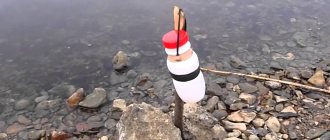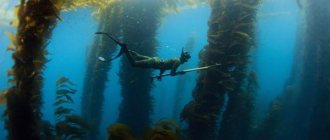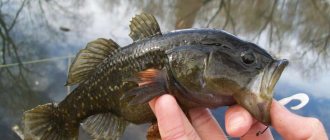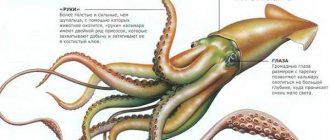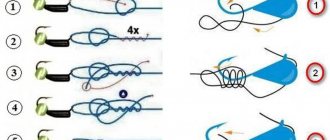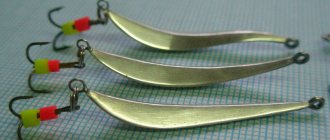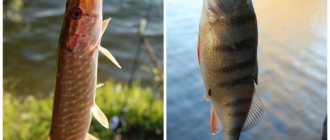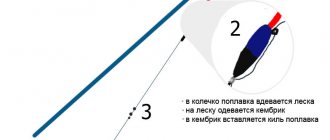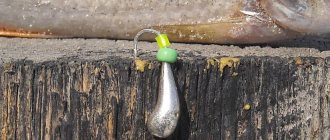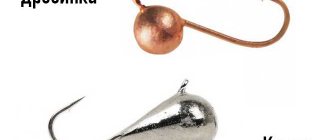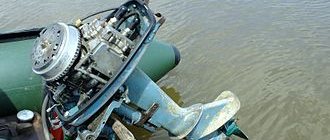Each fisherman has his own arsenal of the most catchy baits that he likes most. All of them are selected carefully and meticulously. Each has its own characteristics and is suitable for fishing in certain conditions. Many fishermen prefer to have jigs in their kit, because they are incredibly catchy and can work in any conditions.
One of the best is the “Witch” jig. It gained its popularity not so long ago, but quite quickly the fishermen recognized it as a real treasure. She is capable of catching any predator if you know how to handle her. So what secrets does this bait keep? What makes it special? All this can be found in the article.
Description of the jig “Witch”
From the very beginning, such baits were called baitless jigs, the shape of which very much resembled the already known devils. The only difference was in the number of hooks; the “witch” had four. Today, “witches” are called jigs, the shape of which is very complex, even the most complex of all types.
Jig device
Its shape resembles a cone, slightly pointed at the bottom, where several hooks are attached using a special wire frame. The hooks can move freely when wiring, this is the peculiarity of the “witch”. It is very difficult to do this, because you cannot make a single mistake.
The hooks are attached in a special way. At the top of the body there is a small depression where a ring is attached, onto which movable hooks are attached. But they must be attached symmetrically, so there are also small grooves on the body.
On older models the ring was rotated 90 degrees. And today the design has become more advanced, because a small limiter is attached to the forend, which prevents it from rising too high. This prevents the bait from getting caught on the fishing line. Also, on the hooks themselves there are small beads of different colors that can move freely along it. To prevent the beads from falling off, they are fixed with cambric.
The principle of “working” of the jig when retrieving
When you lower such a bait into the water, its body will sink much faster than the hooks, since it weighs much more. This leads to the fact that the hooks sink more slowly; when you lift the bait, they will be pressed against the body.
When you lower and raise the “witch,” the jig makes swings with its hooks, which is very reminiscent of the movement of a beetle that has fallen into the water. Such a game can lure fish not only with its appearance, but also with the vibrations of the water, which the fish catches perfectly.
Tackle for fishing with a “witch” jig
A few simple tips for selecting gear for such bait:
- You can use any jig fishing rod. After all, when fishing with such a bait, there is no need to frequently swing the rod, creating frequent vibrations. Therefore, there are no special requirements for the nod; the fisherman can choose any one to suit his taste.
- The line is within 0.12-0.14 mm. But it all depends on the weight; the smaller the jig, the thinner the fishing line should be.
- It is very important to check how the hooks are attached during transportation, because there are several of them. And even if two of them can be stuck into the handle, then the third one will still have to be put on a piece of foam rubber or foam.
The best types of rewinder
Banana
- A common borer, shaped like the same fruit.
- It is tied to the fishing line by the ring of a sharp single hook No. 18-20 protruding from the upper part of the bait’s body.
- Commercially available models of such bait weighing from 0.2-0.3 to 0.5-0.7 g can have different colors: silver, gold, copper, as well as bright monochromatic (acid green, red) or “striped” .
- Used for catching perch and roach at depths of up to 3-4 m.
[THERE IS AN ANSWER] How to properly catch jellyfish with a reelless reel
Klopik
- A legendary baitless bait that has the asymmetrical shape of a ball truncated in half, a drop.
- The outer surface of the body is dark in color, and the inner surface, smooth or slightly convex, facing the tip of hook No. 16-18, is silvery and golden.
- Some models have a red eye painted on the inner surface using paint.
- In most cases, small-sized Klopiki are made of heavy tungsten and weigh 0.5-0.6 g, thanks to which they can be used for fishing at various depths.
- A tungsten baitless bait, reminiscent in shape of Uralka, weighing 0.15-0.3 g, with a small double No. 17 rigidly sealed into the body.
- Available in classic colors - gold, silver, copper, black.
- The Koza is used for catching large roach and perch throughout the ice fishing season.
Ant
- The bait is shaped like the body of the insect of the same name.
- Its body weighing 0.2-0.3 g consists of 2-3 spherical sections of different diameters.
- Available in traditional gold, silver and copper colors, equipped with a single hook No. 18-20 with a long shank.
- Used for catching large roach and bream.
- Tungsten baitless bait weighing 0.2-0.3 g in body shape resembling a small fly without wings: it has two small spherical sections (head and chest) and one posterior ovoid, pointed (abdomen).
- Various models have 5 classic colors: gold, silver, nickel, copper, black.
- The jig is equipped with a sharp hook with a long shank No. 18-20
- During the winter season, large roach, bream, and trophy perch are caught with it.
Nymph
- A baitless jig that has a body resembling an insect larva and consisting of a small head and an elongated belly, ending with a sharp single hook No. 18-20.
- On sale, the Nymph is found in both simple solid colors (golden, copper, silver, black), and in brighter and more complex colors (green, red, yellow with transverse stripes, etc.).
- Mainly bream, large and medium roach are caught with this bait.
Uralka
- This is one of the most popular and catchy models, having the shape of a curved elongated drop.
- Equipped with a sharp single hook No. 16-18.
- The most catchy baits of this type are models of silver, black or golden color.
- Thanks to the variety of models of different weights (from 0.3 to 0.6), Uralka is used both for fishing for medium and small perch in the coastal zone, and for deep bream fishing in pits.
Devil
A tungsten or lead no-attachment jig suspended strictly vertically with a drop- or stick-shaped body of silver, golden or black color, a rigidly soldered or suspended tee in the lower part. Widely used for winter trophy fishing for large perch, roach, bream.
Fishing
- this is not just one of the types of pastime for men. This is a way to relax both soul and body, completely withdraw into yourself, clear your thoughts and restore strength. This is a hobby that most men would gladly prefer to lazily relaxing in front of the TV after a hard week at work.
Fishing
- this is not just one of the types of pastime for men. This is a way to relax both soul and body, completely withdraw into yourself, clear your thoughts and restore strength. This is a hobby that most men would gladly prefer to lazily relaxing in front of the TV after a hard week at work.
Returning from fishing, they feel like breadwinners, real heroes, owners of a golden trophy. In addition, this is not only a good way to be alone with yourself, but also one of the options for eating rich fish soup or juicy grilled fish for lunch. This is why men love everything related to fishing so much.
The skill of fishing is honed over years, or even decades. Each fisherman has his own fishing secrets, which they willingly share, just like housewives share their recipes for signature dishes. Probably everyone (even non-fisherman) knows that the main key to successful fishing is good bait.
Each man has his own list of “favorites” in this matter. Each of them has its own characteristics and each requires a special approach. But jigs, which are particularly catchy and adaptable to any fishing conditions, have recently become the “favorites” of many sailors.
The most popular among fishermen was the “Witch”. Although its use was found not so long ago, the name itself directly screams that if you know the special control levers, then fishing with a witch in winter can bring you even the largest predator. So why is this famous tackle so good and what is its secret?
Fishing in winter on a witch
Simply put, the Witch is a winter lure that has one of the most complex shapes. Its peculiarity is that it has a conical shape with single, freely suspended hooks attached to the body. They are attached to a special wire frame with three loops. Beads are usually strung onto hooks to imitate bait.
The peculiarity of fishing with the “Witch” is that when lowering the fishing rod into the water, the base of the bait will sink much faster than the hooks due to the difference in weight. And when it is raised, the hooks will be pressed against the cone. From the outside, the movements that the hooks will make are reminiscent of how the paws of a beetle moving in water.
It is important to know that fishing with this tackle will be effective only if the wiring is uneven. That is, the fisherman must make a sharp jerk upward, and then let it fall smoothly. The combination should be performed several times in a row. As practice shows, fish are well “led” to such a trick, which makes such a jig very convenient for fishing.
Catching perch with a witch in winter
Perch is one of the fish that finds it especially difficult to refrain from reacting to such a bait. This predator is greedy for active bait, so your actions with the tackle should also be very daring so that the perch is “provoked” to attack. By the way, it attacks most often when the jig touches the bottom. This means that you will have to be quite thoughtful and experiment with the long nod.
[THERE IS AN ANSWER] How to tie a rewinder with an eye
Most often, in this case, they use a “witch” with a slightly longer base and a nod of 25 centimeters in length. This is the optimal size that will allow your tackle to freely touch the bottom and catch large fish. Some fishermen are especially resourceful in this matter, using the eyes of another fish or its fins as bait.
Catching bream in winter using a witch
Bream
- This is a trophy fish. It’s rare that a fisherman manages to boast of bream in winter. Even considering the fact that this fish is quite common in freshwater rivers, a good catch is extremely rare. Bream is a smart and cautious fish that is not so easy to deceive.
Therefore, the fisherman must prepare properly: by choosing the right gear, bait and fishing location.
Due to anatomical features, it is more convenient for fish to look for their “lunch” on the edges. This fish loves depth, so it is unlikely to be found in shallow water. The holes should be made above the supposedly deepest zone at a distance of 10-15 meters from each other. Unlike perch, bream is better caught on stationary tackle.
Bream is very shy and reacts poorly to noise and disturbance. If the bream is not caught on a stationary jig, you should twitch it and then stop it again. You can also use the technique of tapping on the bottom. It is better to use bloodworms or maggots as bait. The fishing line must be at least 20 meters long. Be carefull! The bream does not come to the hole immediately, but after some time.
Catching a witch in winter tricks
The “witch” itself is designed for catching large fish. Due to its size and shape, the little thing is literally scared of her. Therefore, it’s worth trying and studying some features that will help you hit the jackpot.
The most important trick is to tap the bottom with a jig. This method is intended for catching the most inactive fish. When the bait is hit once, the oscillation is maintained, just as with a simple descent and rise. The turbidity rises, which forces the fish to come closer and take a closer look. At this moment you need to sharply raise the bait by 30 centimeters. This maneuver confuses the fish. From the outside, it looks like a frightened beetle that suddenly stood up and kicked up dirt with its paws.
The length of the nod should be about 25 centimeters. This size is very suitable for fishing, although not everyone knows this trick. This nod softens the impact well on the bottom and straightens out if the bait goes deep into the silt.
It is important to remember that the witch should only go a little into the mud, the hooks should remain at the top. It is in this position that fish are most often caught for profit. The witch should be painted either black or brown. Bright colors often alert fish. A negative feature of the witch is that, due to its shape, it often clings not only to fish, but also to the grass, writhing, so you should have a rather large supply of bait in your stash.
So, the first basic movement of the jig is a uniform rise with a fairly high frequency and low amplitude . Among fishermen, this type of bait presentation is often called “dribbling,” “jerking,” or “shaking.” It works better on active fish at the beginning of winter, when they are mobile and respond well to the bait offered.
Features of fishing with a “witch” jig
It’s not enough just to buy such a jig, you also need to know how to use it. Know the secrets that will help the “witch” reveal all of herself and catch a large amount of prey.
What kind of fish bites the “witch”?
With its help you can very easily catch fish such as:
- Perch
- Gustera
- Roach
- crucian carp
- Bream
With the “witch” you can catch any prey, even very cautious ones. And its feature helps to cut off unnecessary little things that so often spoil the whole fishing experience.
Fishing tricks
As mentioned above, it’s not enough to just buy, you also need to know the secrets of playing correctly. In order for the “witch” to actively wave its hooks, attracting attention, it is necessary not only to conduct the wiring with vibrations of different frequencies and strengths, but also to move it up and down in the layers of water.
It is very effective to first raise the bait, actively shaking the rod, and then slowly lower it without moving a few centimeters. Then take a short pause and again raise it a few centimeters. This allows you to very realistically imitate an insect that moves in the water column.
A good effect is achieved by lightly tapping the bait on the bottom; this also allows the “legs” to move, attracting prey.
You need to be very careful and careful, because with such hooked feet the jig very easily clings to all the protrusions, snags or algae.es here
Fishing tactics and techniques
Tactics
The tactics of catching a witch are, first of all, searching for fish or at least places that are promising for fishing. In the case of perch fishing, fishing should be carried out, as when fishing with a spoon or a balance beam. It usually takes five minutes for the perch to react to the bait.
If there is no bite or at least indirect signs of the presence of a predator (perches caught by neighbors, hitting the fishing line), you can safely move on. If you still want to find the key to a possibly passive perch, you can try changing the game.
Expert opinion
Knipovich Nikolai Mikhailovich
Zoologist, hydrobiologist. I am interested in fishing at a professional level.
In many reservoirs, perch stays not only near the bottom, but also in half-water. Many anglers forget about this, although sometimes in the middle layers you can catch much more than at the bottom.
When fishing the middle horizons, you will have to stay on the hole a little longer.
When fishing for perch, reference points are usually other anglers. Of course, it is better to find the fish yourself, but if this fails, then you can join the fishing “in the crowd.” But it never hurts to remember the rules of fishing ethics. However, if when fishing with a lure it is considered indecent to drill closer than 30 meters from the nearest angler, then fishing with a jig is permissible at a much closer distance.
During winter fishing, an independent search for perch is carried out, guided by the coastal topography, ice structure (sometimes cracks show sharp changes in depth) or using an echo sounder. The latter will show not only the depth and presence of fish, but also how the perch reacts to the bait. You can also focus on the distribution of snow on ice:
- if the ice is almost clear, then it is better to fish on snow spots;
- and on snow-covered ice, choose snow-free areas.
Little fishing tricks like these often bring success.
Technique
The fishing technique refers, first of all, to the wiring and the sequence of movements performed. Catching perch requires high-frequency, low-amplitude fishing, in other words, the angler must make very fast movements, which is achieved not so much by the use of hands, but by the work of the nod, which is why it is so important.
The sequence of operations performed is as follows:
- The witch is lowered to the bottom and hit it several times to create a cloud of turbidity.
- Slowly raise the jig up, constantly playing.
- They pause, during which bites often occur.
- Raise the witch even higher.
- Having reached a distance of 1 meter from the bottom, they begin their descent.
- They play with the jig in one place, and then slowly lower it without making any movements.
- This way they reach the bottom.
- Repeat the sequence of operations several times.
It should be noted that the same witches can be used to successfully catch both roach and bream:
- Roach loves mid-frequency action, and when fishing for bream the action should be slow.
- Bream often takes a pause, raising the nod upward.
- The bream usually bends its nod downwards.
- White witchfish are often caught using bait, but the fishing tactics differ from sitting passively waiting for a bite.
Drill several holes at once and feed each one. Then they are caught one by one, without stopping for long
Usually several holes with a higher concentration of fish are identified and special attention is paid to them
Expert opinion
Knipovich Nikolai Mikhailovich
Zoologist, hydrobiologist. I am interested in fishing at a professional level.
In case of very low fish activity, it is not forbidden to attach one bloodworm larva or several burdock moth larvae to the hook.
The fishing technique also includes hooking and retrieving prey. Since the fishing line is thin, the hook should be carefully, and the fishing should not be forced, especially if the fish caught is not small.
Make a “witch” jig with your own hands
You can make such a jig yourself. Even though it looks complicated, the work is quite simple. To do it you need a little time and desire. Anyone can make it if you have the right materials.
What you will need
- Olive sinker 2.5 g
- beads of different colors - 10 pcs.
- Hooks with long shank - 3 pcs.
- Medium thickness wire
- Marker black
- Pliers
- File
- Hacksaw for metal
Manufacturing process
After preparing all the necessary materials and tools, you can begin the work itself.
Manufacturing stages:
- From the very beginning, you should cut the weight into two parts. To prevent it from slipping, you can pinch it with pliers. There is no need to rush, because the cut should be even.
- Then sand one half, removing all irregularities and sharp edges.
- Then clamp half of the sinker again and start sawing, but not all the way. Also, you should make a small notch a few millimeters from the top.
- Take a small piece of wire, fold it in half and twist, leaving a small loop on top.
- Insert the wire into the weight so that the loop is at the top. After this, squeeze the weight so that the wire is securely clamped with parts of the olive.
- Use a black marker or paint to paint both the sinker and the wire.
- Leaving a few millimeters, cut off the excess wire.
- Place several multi-colored beads on each hook and thread them into the wire.
- After this, secure the wire itself in the recess, just do not tighten it too much so that the hooks can move. Trim off all excess so that it does not interfere.
Reviews from fishermen about the “Witch” jig
User Andrey writes that the “witch” is quite interesting, plays very temptingly, so the fish constantly bite. Sometimes even two fish in one run. Grade:
User Dima writes that he has used it several times, it is quite good at catching peaceful fish, but if you want a predator, then the “witch” is not very suitable. It's better to take something else. Although it catches great perch. Grade:
User Vitaly writes that he caught bream with it this year, but didn’t catch anything, so he’s upset. Although it itself is very unique, and works great on other fish. Grade:
User Mikhail writes that he made such a jig himself, since he could not find it anywhere. It works well, there is always a catch and the bite is constant. Grade:
User Konstantin writes that such a jig perfectly cuts off small things, and therefore it is good for hunting larger prey. Grade:
User Serge writes that this bait is very unique, it is very interesting to watch its play, and how the fish swim and try to grab the “foot”. Perch and roach take it well; no bream have been caught yet. The prey is quite large, although the little things try to peck, they don’t interfere as much as usual. Grade:
User Andrey writes that he bought the “witch” and used it several times, quite successfully. A little later I decided to do it myself, now there are two “witches” who bring good loot. Grade:
“The Witch” very quickly gained popularity not only among beginners, but also among professional fishermen. They perfectly imitate an insect, so they can attract quite a lot of fish, even very cautious and shy ones. For fishing to bring a lot of prey, you need to be able to play the game correctly, and then there will be no end to the bite.
Advantages and disadvantages
Like any tackle, the “witch” is not universal. Its use has not only obvious advantages, but also disadvantages.
- The undoubted advantages of this type of bait include:
- Possibility of use both in winter and summer;
- it is suitable for large fish and at the same time repels small ones well, which can interfere with the catch;
- high efficiency even without the use of bloodworms.
- This jig has few disadvantages:
- difficulty of use for beginners, it is necessary to adapt and study the peculiarities of movement and vibrations of the tackle;
- more suitable for fishing at depths of up to 4 m.
Did you know? The name of the tackle comes from the word “mormysh”. This is the name given to freshwater crustaceans used as bait in the Urals.
